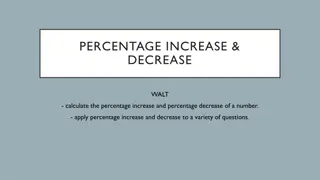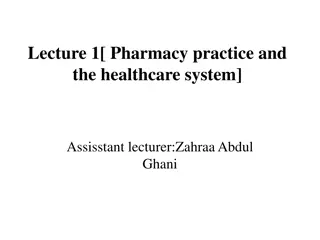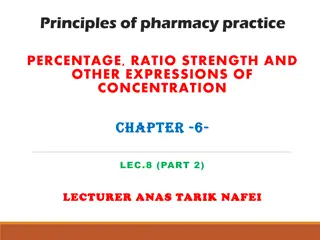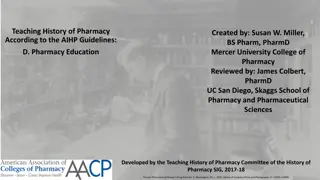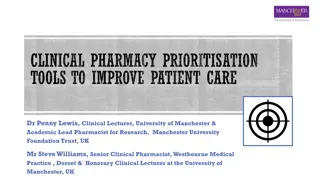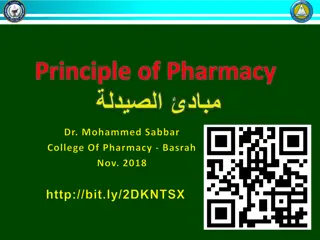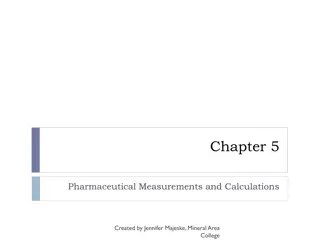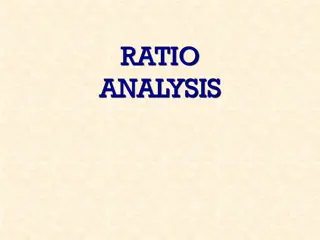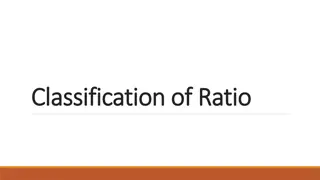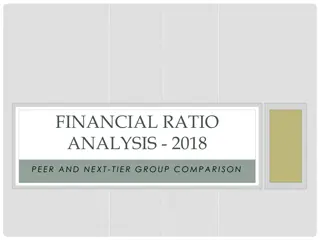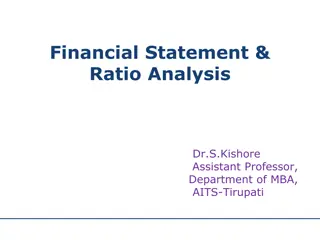Pharmacy Practice: Percentage and Ratio Strength Calculations
Understanding percentage and ratio strength calculations is crucial in pharmacy practice. Percentages can be expressed as fractions or decimals, and various concentrations like weight-in-volume and volume-in-volume are used in pharmaceutical preparations. Learn how to calculate the correct strength of solutions and preparations, such as determining the grams of a constituent in a specific volume. Practice examples include finding the grams of dextrose needed for a 5% solution and calculating the grams of potassium permanganate for a 0.02% prescription.
- Pharmacy Practice
- Percentage Calculations
- Ratio Strength
- Pharmaceutical Preparations
- Drug Formulations
Download Presentation

Please find below an Image/Link to download the presentation.
The content on the website is provided AS IS for your information and personal use only. It may not be sold, licensed, or shared on other websites without obtaining consent from the author. Download presentation by click this link. If you encounter any issues during the download, it is possible that the publisher has removed the file from their server.
E N D
Presentation Transcript
Principles of pharmacy practice Percent and ratio strength calculations
Percent and ratio strength calculations Percentage The term percent and its corresponding sign (%) mean by the hundred or in a hundred, and percentage means rate per hundred , so 50 percent (or 50%) and a percentage of 50 are equivalent expressions. A percent may also be expressed as a ratio, represented as a common or decimal fraction. For example, 50% means 50 parts in 100 of the same kind, and may be expressed as 50 100 or 0.50 For the purposes of computation, percents are usually changed to equivalent decimal fractions. This change is made by dropping the percent sign (%) and dividing the expressed numerator by 100. Thus, 12.5% = 12.5/100 = 0.125
The percentage concentrations of active and inactive constituents in various types of pharmaceutical preparations are defined as follows by the United States Pharmacopeia1 Percent weight-in-volume (w/v) expresses the number of grams of a constituent in 100 mL of solution or liquid preparation and is used regardless of whether water or another liquid is the solvent or vehicle. Expressed as: % w/v. Percent volume-in-volume (v/v) expresses the number of milliliters of a constituent in 100 mL of solution or liquid preparation. Expressed as: % v/v. Percent weight-in-weight (w/w) expresses the number of grams of a constituent in 100 g of solution or preparation. Expressed as: % w/w. The term percent, or the symbol %, when used without qualification means: for solutions or suspensions of solids in liquids, percent weight-in-volume; for solutions of liquids in liquids, percent volume-in-volume; for mixtures of solids or semisolids, percent weight-in-weight
Percentage weight in volume weight-in-volume expressions, the correct strength of a 1% (w/v) solution or other liquid preparation is defined as containing 1 g of constituent in 100 mL of product Multiply the required number of milliliters by the percentage strength, expressed as a decimal, to obtain the number of grams of solute or constituent in the solution or liquid preparation. The volume, in milliliters, represents the weight in grams of the solution or liquid preparation as if it were pure water. Volume (mL, representing grams) x decimal) = grams (g) of solute or constituent % (expressed as a
How many grams of dextrose are required to prepare 4000 mL of a 5% solution? 4000 mL represents 4000 g of solution 5% = 0.05 4000 g x 0.05 = 200 g, answer. How many grams of potassium permanganate should be used in compounding the following prescription? Potassium Permanganate 0.02% Purified Water ad 250 mL Sig. as directed. 250 mL represents 250 g of solution 0.02% = 0.0002 250 g x 0.0002 = 0.05 g, answer
How many grams of aminobenzoic acid should be used in preparing 8 fluidounces of a 5% solution in 70% alcohol? 8 fl. oz. = 8 x 30 mL = 240 mL 240 mL represents 240g of solution 5% = 0.05 240 g x 0.05 =12 g, answer.
Percentage volume in volume In preparing 250 mL of a certain lotion, a pharmacist used 4 mL of liquefied phenol. What was the percentage (v/v) of liquefied phenol in the lotion?
Calculating Percentage Strength Weight-in-Weight If the weight of the finished solution or liquid preparation is not given when calculating its percentage strength, other data must be supplied from which it may be calculated: the weights of both ingredients, for instance, or the volume and specific gravity of the solution or liquid preparation. If 1500 g of a solution contains 75 g of a drug substance, what is the percentage strength (w/w) of the solution?
The concentrations of weak solutions are frequently expressed in terms of ratio strength. Because all percentages are a ratio of parts per hundred When a ratio strength, for example, 1:1000, is used to designate a concentration, it is to be interpreted as follows For solids in liquids 1g of solute or constituent in 1000 mL of solution or liquid preparation. For liquids in liquids 1 mL of constituent in 1000 mL of solution or liquid preparation. For solids in solids 1g of constituent in 1000 g of mixture. The ratio and percentage strengths of any solution or mixture of solids are proportional, and either is easily converted to the other by the use of proportion.
Occasionally, pharmacists, particularly those practicing in patient care settings, need to convert rapidly product concentrations expressed as percentage strength, ratio strength, or as grams per liter (as in IV infusions) to milligrams per milliliter (mg/mL)
The strengths of very dilute solutions are commonly expressed in terms of parts per million (ppm) or parts per billion (ppb), i.e., the number of parts of the agent per 1 million or 1 billion parts of the whole





